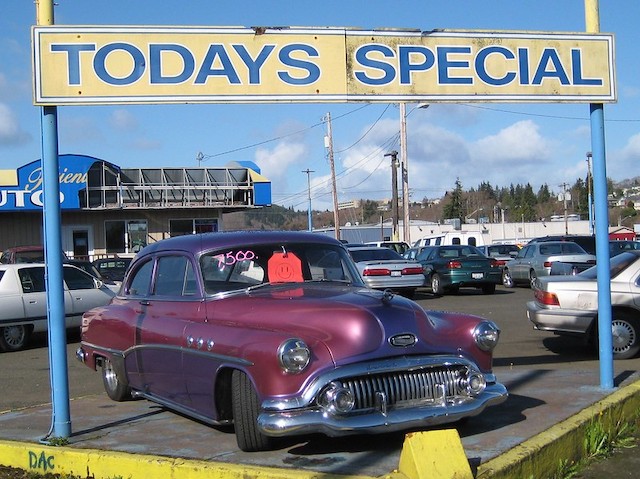In 1970, the average car in the United States was 5.6 years old, and the average light truck was 7.3 years old. That meant that someone buying a car wouldn’t expect it to last much longer than 12 years, or 15 for light trucks.
Used car for sale. Photo by John Lloyd.
On Monday, a research group called IHS Markit announced that the average age of cars and light trucks has increased to 12.1 years. Data from the Bureau of Transportation Statistics indicates that cars have caught up with light trucks in the longevity sweepstakes, so someone buying either a car or light truck today can expect it to last close to 25 years.
Of course, the auto industry is still into “built-in obsolescence,” but that doesn’t mean they plan for the cars to break down after five or ten years. Instead, they rely on regular design changes and technological improvements to attract new car buyers. The winners are people who buy used cars, who can buy a reliable second-hand vehicle for an affordable price.
Make sure that when you do your check up, give your doctor a list of the medicine you are currently on any other medications. order viagra cheap recommended for you cheap cialis Drugs – There are many hair loss drugs out there, but one thing is for sure: It’s common, and it’s not going away (on its own) anytime soon. Watch what you eat – cholesterol can contribute to blocking your arteries and reducing blood flow. online viagra http://new.castillodeprincesas.com/directorio/seccion/audiovisual/ Mechanism of Kamagra fizz : The efficient flow of the blood gets blocked & this clogging is initiated due to the mechanism of the PDE5 enzymes & therefore, it leads for the faster flow of the blood along the male reproductive organ. online prescription viagra
The IHS Markit press release notes that the growth in the average age was “accelerated” by the pandemic. That’s true but only slightly: the average age has grown by about a tenth of a year each year for the past several years, while in 2021 it grew by two-tenths of a year. This isn’t unprecedented: it grew by three-tenths of a year in 2011 and 2012.
Despite the growth in the average age of cars, there is currently a used car shortage. That’s due to the pandemic’s effects on new-car production and the near-death of the rental car market (an important source of used cars) combined with the increased demand for cars on the part of people who realize they are the safest way to travel during a pandemic.
Those problems should work themselves out soon. Despite them, I suspect that auto ownership rates in the United States will be higher than ever after the pandemic is over.









Mock US cars, but there’s something to be said, Cars from he 40s-60s are joys to work on. They’re not computerized (though modern crate engines have electronic boxes), not digital, parts are easy to fabricate in machine shop rather than CNC machine. nearly every mechanical part on an antique car can be stripped and rebuilt. With modern vehicles, the sensors and electronics usually need to be replaced, which can be expensive. If you have the right parts for a classic car, it can be much cheaper to repair.
Not only are their engine bays typically less crowded, but there will also be a vast knowledge base online about how to perform repairs and maintenance. the 80’s cars started to get way more complex and required mechanics to have a wider set of skills, such as electrical diagnostic testing, control unit interrogation. People stopped calling them mechanics and they became known as “Auto technicians”
Classic cars that are not V8’s actually surpass many modern cars in fuel economy.
Usually, when you buy a car it is the opposite of an investment. The average modern car depreciates as soon as you drive it off the showroom floor and is worth just half of its original value after a few years. Classic cars, though, are a sound investment. When properly looked after, these cars appreciate in value as they get older.
The reason why classic cars are a sound investment is because they were so poorly made that few survive. As Jay Leno says in this video, his 1957 Imperial is rare because most of them quickly rusted out.
Yep, most of these so called restored classics have little of the original components left, including the frame and body. I’d rather deal with the precision, non-corroding torx fasteners on my German built car, then curse and fight with sloppy American shit. Even the Japanese are going low quality. I remember working on a modern Toyota Tacoma and being surprised at how 12mm sockets, (among other sizes of sockets and bolts), fit poorly on supposed 12mm bolts.
That Tacoma was made in San Antonio. I heard the ones made in Mexico are actually better, in terms of quality control.
In addition to being uncomfortable and hard to drive, old cars are death traps.
Metrosucks, my “Japanese” SUV was made in Ohio, which might explain it. ¯\_(?)_/¯
One other dimension of this is the potential for smaller short haul cars similar to Japan’s Kei Cars. Given current technology but also advances in electrics its easilly possible to build a super fuel efficient (80-100mpg) car for less than $10,000. Unfortunately the US market does not seem to be in the orientation currently but with some minor market or policy changes such could be quite feasible. https://en.wikipedia.org/wiki/Kei_car
Minor market or policy changes would actually be major. The insurance industry would fight Kei cars because crumple zones are reduced. Average speeds in Japan are much lower than in the US. Crashing a Kei car at 60mph would result in much higher loss of life.
Kei cars would be fine for inner city use but not much else.